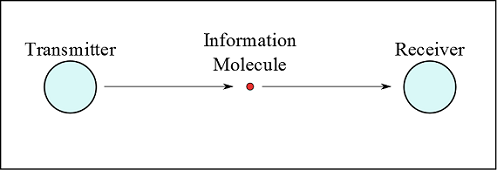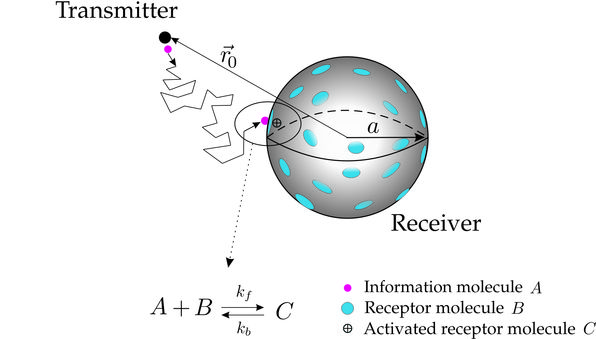Molecular Communications
Current Project Members
- Prof. Dr.-Ing. Robert Schober
- M.Sc. Arman Ahmadzadeh
- M.Sc. Vahid Jamali
- M. Sc. Wayan Wicke
Current Master Students
- Tobias Schwering
- Zhao Mengyu
Problem Overview
Recent interest has developed in the design of communication networks between devices that are much smaller than those in conventional networks. Such devices may have components that are on the order of nanometers in size and are referred to as nanomachines. The ability of these devices to communicate amongst themselves, i.e., via the formation of synthetic nanonetworks, is essential since they would have limited individual computational capacity.
Molecular communication is a nanonetwork design strategy where a transmitter emits information molecules that are carried to an intended receiver. This strategy can take advantage of the many mechanisms in cells and subcellular structures that already use the emission of molecules for communication. Biocompatibility (i.e., the potential to integrate such networks inside of living organisms) is also a possible advantage of this technique.
The simplest propagation method using molecules, which does not require any prior infrastructure between a transmitter and receiver, is free diffusion. Small molecules released by a transmitter can diffuse very quickly over short distances (up to a micrometer scale). Diffusion is a common means of communication in existing biological nanonetworks, such as amongst communities of bacteria and cells in a tissue.

Potential Applications
1) Biomedical Applications:
- Health monitoring: Monitoring performed within an organism enables identification of specific molecules in the body, that may serve as a bio-marker for a disease or a certain medical condition.
- Drug delivery: Implanted bio-nanomachines can use molecular signals within the organism, or molecular signals released by other bio-nanomachines, to pinpoint target locations for drug delivery and thereby reduce the potential for side-effects at non-target locations.
- Regenerative medicine: Bio-nanomachines made of living cells can divide and grow to form a functional structure (e.g., tissues and organs). Molecular communication provides techniques to control patterns of communication and thereby affect the growth and differentiation of the bio-nanomachines into specific structures.
- Genetic engineering: Manipulation and modification of nano-structures such as molecular sequences and genes can be achieved by nano-machines. The use of nanonetworks will allow expanding the potential applications in genetic engineering.

2) Environmental Applications:
- Environment monitoring: Information about molecules of toxic or radioactive agents could help to identify problems and to provide a map for cleaning up the environment in response to illegal contamination or an accidental spill. Bio-nanomachines can be integrated into large or microscale environments to map out the locations of molecules within that environment.

- Biodegradation: There is an existing and growing problem with garbage handling around the world. Nanonetworks can help the biodegradation process by sensing and tagging different materials that can be later located and processed by smart nano-actuators.
3) Industrial and consumer goods applications:
- Food and fluids quality control: Nano-sensor networks can help detecting small bacteria and toxic components that can affect to the product quality and cannot be detected using traditional sensing technologies.
- Functionalized materials and fabrics: Nanonetworks can be included in advanced fabrics and materials to get new and improved functionalities. Antimicrobial and stain-repeller textiles are being developed using nanofunctionalized materials.
- Pattern and structure formation: Molecular communication can be used to control the transport of molecules, and can be modified to produce novel patterns of molecules. A system can be programmed to form a specific pattern of molecules by having each location in the system correspond to an address and then transporting bio-nanomachines or specific types of molecules to each address. After the molecules or bio-nanomachines are transported to each address, chemical processes can be activated to complete the structure.




